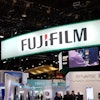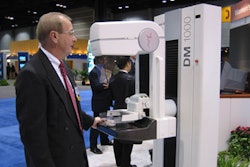CHICAGO - A 1.5-tesla MRI scanner and a 64-slice CT system are spearheading the list of new product introductions at the RSNA conference this week for Siemens Medical Solutions of Malvern, PA. The company is also launching a new mid-range PACS offering targeted at large radiology practices and community hospitals.
Magnetom Avanto is a 1.5-tesla scanner based on a new magnet design with a 1.5-m bore. But what makes Avanto unique is Total imaging matrix (Tim), a surface-coil design that enables users to plug up to 10 gradient coils into the patient table before the exam starts, according to Laurie Fisher, marketing manager for high-field products. Clinicians can then conduct the exam without having to remove the patient from the magnet to swap new coils in and out, enabling whole-body exams of up to 205 cm of coverage to be conducted in 12 minutes.
Siemens also beefed up the channel count in Tim coils, which now feature 76 coil elements and 32 radiofrequency (RF) channels. This compares to eight channels and 16 elements on Magnetom Symphony, previously the company's flagship 1.5-tesla scanner. Avanto's gradients are rated at 45 m/T/m amplitude and 200 T/m/s at a 50-cm field of view.
The first Avanto was installed at New York University in New York City in November, Fisher said, and Food and Drug Administration clearance was received in October. Commercial deliveries are scheduled for February.
Tim is applicable to other MRI scanners in Siemens' product line besides Avanto. The company's Symphony, Sonata, and Trio scanners can be upgraded with the new coil technology.
Siemens' entry into the multislice CT race is Somatom Sensation 64, which collects 64 slices per gantry rotation using 32-channel detectors. Siemens accomplishes this feat through the design of its new Straton x-ray tube, which is capable of toggling into different positions to produce two x-ray beams emanating from the tube at once, according to Bernd Ohnesorge, vice president of CT marketing and sales.
The Straton tube is also unique in that it eliminates the need for heat storage by enabling direct contact between the tube anode and cooling oil, with all bearings located outside of the tube's vacuum. The tube has a cooling rate of five million heat units (MHU) per minute, meaning that it cools down almost instantly, according to Siemens. The Straton design enables the tube to tolerate higher G-forces, which in turn supports faster gantry rotation speeds. Sensation 64 has a 0.37-second rotation speed.
Sensation 64 also features isotropic spatial resolution of 0.4 mm. Previous Siemens multislice scanners had a spatial resolution of 0.6-0.7 mm and did not have isotropic voxels.
Siemens expects commercial shipments of Sensation 16 to begin in the fall of 2004, and the scanner should carry a list price of about $1.3 million to $1.5 million, about 30% higher than a Sensation 16.
Other Siemens CT advances include Somatom Sensation Open, a new scanner with an extra-wide 82-cm patient bore for specialty applications, and new software for computer-assisted evaluation of lung nodules. Siemens said the software received 510(k) clearance two weeks ago and will be available on CT scanner consoles and the company's Leonardo image processing workstation.
In PACS, Siemens introduced Cosmos, a work-in-progress mid-tier PACS network targeted at large radiology practices or radiology departments at community hospitals with complex image management needs. It’s suitable for management of up to 100,000 studies a year, Siemens said.
Cosmos workstation software is Java-based, allowing users to remotely install workstation applications via Java beans, according to Rik Primo, manager of marketing and strategic relationships.
A single sign-on Cosmos feature allows users to access RIS, as well as postprocessing and image review applications. An iMaxcess feature groups PACS images and compresses them via the JPEG 2000 format for transmission over networks.
Cosmos is scheduled to be installed at beta sites in January, with general availability expected for April. The vendor’s flagship Magic software has received additional advanced postprocessing applications, such as PET/MR fusion capabilities.
Targeted at non-U.S. customers, Sky is a miniPACS network designed for private practices and hospitals with up to 50,000 exams per year. Siemens has no current plans to bring Sky to the U.S. market, Primo said.
Siemens has also added a color monitor to its Integrated Radiology Suite. The display is capable of viewing text or color image data, according to the firm.
A new, upgraded version of the biograph PET/CT scanner is being featured in the nuclear medicine section of the Siemens booth. The new system employs Hi-Rez detectors, using lutetium oxyorthosilicate (LSO) materials, that produce a 250% improvement in volumetric image resolution, according to Markus Lusser, vice president of worldwide sales and marketing at the company's nuclear medicine group. The new biograph is also capable of collecting diagnostic-quality images in less than a minute, with 4.6-mm spatial resolution.
Siemens has offered biograph in two-slice and 16-slice CT configurations, and at this year's meeting has added a six-slice version to the mix. Another Siemens nuclear medicine product highlight is c.cam, a dedicated cardiac camera with fixed 90° dual heads and a reclining chair rather than a patient table. Siemens said the system is targeted at the nuclear cardiology niche, the only segment of the SPECT market that is showing growth.
Siemens is also discussing research it is conducting on solid-state digital detector materials. Siemens has not yet determined what type of material would be optimal, but is close to installing a prototype camera. Such a system probably would not resemble a conventional gamma camera, but rather would be designed for specialty applications such as operating-room use, Lusser said.
On the x-ray side, Siemens announced that the FDA cleared its new mobile x-ray system, Mobilett XP, just before the RSNA show. Mobilett XP has 10 times more imaging power and improved handling than previous models.
The self-calibrating platform’s radiographic output is up to 30 kW and 360 mAs, enabling exposure times as short as 1 millisecond and virtually eliminating motion blurring. Short exposure times produce sharp images that enhance the unit's utility in coronary care and neonatal units, according to the company.
The platform’s compact size and lightweight construction allow the operator to move the system around obstacles. Featuring a hybrid power system, Mobilett XP Hybrid is equipped to operate from either rechargeable batteries or from a conventional wall power supply.
Also new this year is Siremobil Iso-C3D, a mobile C-arm with intraoperative 3-D imaging capabilities. The system is equipped with the open interface NaviLink, and is compatible with nearly all navigation systems offering direct 3-D navigation in the OR.
Siemens' ultrasound division is featuring its Paragon release, which provides workflow and imaging enhancements for the premium Acuson Sequoia scanner.
The Paragon upgrade option is available on the Sequoia 512 system and includes an expansion of the vendor’s TEQ technology. The system allows clinicians to optimize a 2-D dimensional image while offering one-button optimization for spectral Doppler imaging, reducing the time spent optimizing image parameters by up to 95%. TEQ for 2-D imaging and spectral Doppler utilizes patient-specific information to compensate for patient-to-patient variables. Paragon includes the new 10V4 transducer, a small-footprint probe for neonatal and pediatric imaging.
Expanded clinical applications for the Sonoline Antares ultrasound system with new transducer and acoustic technologies are also being showcased, along with the company’s fourSight 4-D imaging technology. The StellarPlus upgrade for the Antares system includes the new PX4-1 matrix-array transducer for transcranial and abdominal imaging, as well as digital dynamic clips, which preserve full digital image quality throughout the exam process in a DICOM standard format.
By Brian Casey, Erik L. Ridley, and Robert Bruce
AuntMinnie.com
staff writers
December
3, 2003
Copyright © 2003 AuntMinnie.com



















